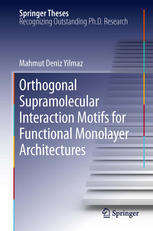

Most ebook files are in PDF format, so you can easily read them using various software such as Foxit Reader or directly on the Google Chrome browser.
Some ebook files are released by publishers in other formats such as .awz, .mobi, .epub, .fb2, etc. You may need to install specific software to read these formats on mobile/PC, such as Calibre.
Please read the tutorial at this link: https://ebookbell.com/faq
We offer FREE conversion to the popular formats you request; however, this may take some time. Therefore, right after payment, please email us, and we will try to provide the service as quickly as possible.
For some exceptional file formats or broken links (if any), please refrain from opening any disputes. Instead, email us first, and we will try to assist within a maximum of 6 hours.
EbookBell Team

0.0
0 reviewsDeniz Yilmaz' thesis describes a combination of orthogonal supramolecular interactions for the design of functional monolayer architectures on surfaces, that can be used as chemical and biosensors in a wide range of applications. The term “orthogonal supramolecular interactions” refers to non-covalent interactions that do not influence each other's assembly properties. Orthogonal self-assembly thus allows extended control over the self-assembly process and promotes new materials properties. The first part of the thesis employs orthogonal host-guest and lanthanide-ligand coordination interaction motifs to create supramolecular luminescent monolayers. The second part of the thesis describes the fabrication of functional monolayers on silicon and gold substrates for applications in electronics.
The results illustrate the power of weak supramolecular interactions to direct the immobilization of functional systems on surfaces. The combination of host-guest and lanthanide-ligand coordination interaction motifs on surfaces demonstrates that hybrid, multifunctional supramolecular monolayers can be fabricated by integrating different non-covalent interactions in the same system. This combination opens up new avenues for the fabrication of complex hybrid organic-inorganic materials and stimuli-responsive surfaces. Their utility is demonstrated through applications of the functional interfaces to biosensing and nanotechnology.